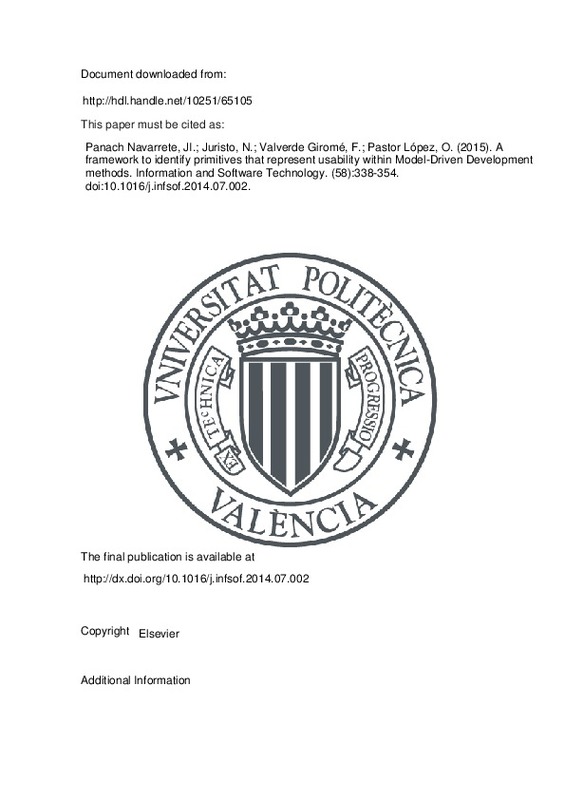JavaScript is disabled for your browser. Some features of this site may not work without it.
Buscar en RiuNet
Listar
Mi cuenta
Estadísticas
Ayuda RiuNet
Admin. UPV
A framework to identify primitives that represent usability within Model-Driven Development methods
Mostrar el registro sencillo del ítem
Ficheros en el ítem
| dc.contributor.author | Panach Navarrete, José Ignacio
|
es_ES |
| dc.contributor.author | Juristo, Natalia
|
es_ES |
| dc.contributor.author | Valverde Giromé, Francisco
|
es_ES |
| dc.contributor.author | Pastor López, Oscar
|
es_ES |
| dc.date.accessioned | 2016-06-02T09:56:06Z | |
| dc.date.available | 2016-06-02T09:56:06Z | |
| dc.date.issued | 2015-02 | |
| dc.identifier.issn | 0950-5849 | |
| dc.identifier.uri | http://hdl.handle.net/10251/65105 | |
| dc.description.abstract | Context: Nowadays, there are sound methods and tools which implement the Model-Driven Development approach (MDD) satisfactorily. However, MDD approaches focus on representing and generating code that represents functionality, behaviour and persistence, putting the interaction, and more specifically the usability, in a second place. If we aim to include usability features in a system developed with a MDD tool, we need to extend manually the generated code. Objective: This paper tackles how to include functional usability features (usability recommendations strongly related to system functionality) in MDD through conceptual primitives. Method: The approach consists of studying usability guidelines to identify usability properties that can be represented in a conceptual model. Next, these new primitives are the input for a model compiler that generates the code according to the characteristics expressed in them. An empirical study with 66 subjects was conducted to study the effect of including functional usability features regarding end users' satisfaction and time to complete tasks. Moreover, we have compared the workload of two MDD analysts including usability features by hand in the generated code versus including them through conceptual primitives according to our approach. Results: Results of the empirical study shows that after including usability features, end users' satisfaction improves while spent time does not change significantly. This justifies the use of usability features in the software development process. Results of the comparison show that the workload required to adapt the MDD method to support usability features through conceptual primitives is heavy. However, once MDD supports these features, MDD analysts working with primitives are more efficient than MDD analysts implementing these features manually. Conclusion: This approach brings us a step closer to conceptual models where models represent not only functionality, behaviour or persistence, but also usability features. (C) 2014 Elsevier B.V. All rights reserved. | es_ES |
| dc.description.sponsorship | This work was developed with the support of the Spanish Ministry of Science and Innovation Project SMART ADAPT (TIN201342981-P), TIN2011-23216 and was co-financed by ERDF. It also has the support of Generalitat Valenciana-funded ORCA Project (PROMETEO/2009/015) and UV (UV-INV-PRECOMP13-115032). | en_EN |
| dc.language | Inglés | es_ES |
| dc.publisher | Elsevier | es_ES |
| dc.relation.ispartof | Information and Software Technology | es_ES |
| dc.rights | Reserva de todos los derechos | es_ES |
| dc.subject | Model-Driven Development | es_ES |
| dc.subject | Usability | es_ES |
| dc.subject | Conceptual model | es_ES |
| dc.subject.classification | BIBLIOTECONOMIA Y DOCUMENTACION | es_ES |
| dc.subject.classification | LENGUAJES Y SISTEMAS INFORMATICOS | es_ES |
| dc.title | A framework to identify primitives that represent usability within Model-Driven Development methods | es_ES |
| dc.type | Artículo | es_ES |
| dc.identifier.doi | 10.1016/j.infsof.2014.07.002 | |
| dc.relation.projectID | info:eu-repo/grantAgreement/MINECO//TIN2013-42981-P/ES/DESARROLLO DE SOFTWARE ADAPTATIVO EN UN MUNDO INTELIGENTE. RETOS TECNOLOGICOS EN EL AMBITO DE LA INGENIERIA DIRIGIDA POR MODELOS/ | es_ES |
| dc.relation.projectID | info:eu-repo/grantAgreement/MICINN//TIN2011-23216/ES/TECNOLOGIAS PARA LA REPLICACION Y SINTESIS DE EXPERIMENTOS EN IS/ | es_ES |
| dc.relation.projectID | info:eu-repo/grantAgreement/GVA//PROMETEO09%2F2009%2F015/ES/Métodos de desarrollo orientados a la calidad de las tecnologías de la información (Orca)/ | es_ES |
| dc.relation.projectID | info:eu-repo/grantAgreement/UV//UV-INV-PRECOMP13-115032/ | es_ES |
| dc.rights.accessRights | Abierto | es_ES |
| dc.contributor.affiliation | Universitat Politècnica de València. Departamento de Sistemas Informáticos y Computación - Departament de Sistemes Informàtics i Computació | es_ES |
| dc.description.bibliographicCitation | Panach Navarrete, JI.; Juristo, N.; Valverde Giromé, F.; Pastor López, O. (2015). A framework to identify primitives that represent usability within Model-Driven Development methods. Information and Software Technology. (58):338-354. https://doi.org/10.1016/j.infsof.2014.07.002 | es_ES |
| dc.description.accrualMethod | S | es_ES |
| dc.relation.publisherversion | http://dx.doi.org/10.1016/j.infsof.2014.07.002 | es_ES |
| dc.description.upvformatpinicio | 338 | es_ES |
| dc.description.upvformatpfin | 354 | es_ES |
| dc.type.version | info:eu-repo/semantics/publishedVersion | es_ES |
| dc.description.issue | 58 | es_ES |
| dc.relation.senia | 302642 | es_ES |
| dc.contributor.funder | Ministerio de Ciencia e Innovación | es_ES |
| dc.contributor.funder | Generalitat Valenciana | es_ES |
| dc.contributor.funder | Ministerio de Economía y Competitividad | es_ES |
| dc.contributor.funder | Universitat de València | es_ES |







![[Cerrado]](/themes/UPV/images/candado.png)

